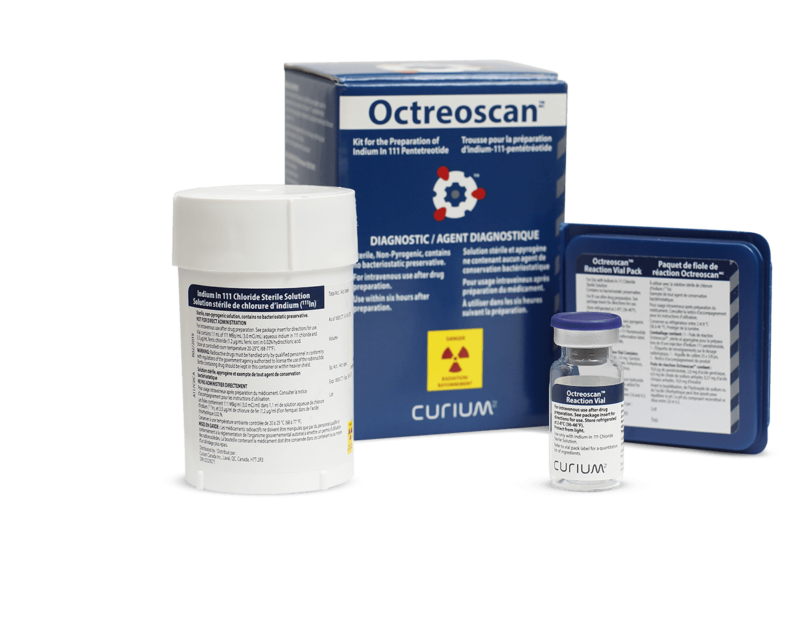

Canada Spect products | Oncology
Octreoscan™
(kit for the preparation of indium In 111 pentetreotide)
This information is intended for Canadian healthcare professionals only.
Product information
To treat the NET, first see the NET.
Octreoscan brings enhanced value to your imaging efforts through:
- Localization of both primary and metastatic neuroendocrine tumors (NETs) bearing somatostatin receptors.1
- Aiding with identification of additional tumor sites not apparent with conventional imaging such as CT and MR.2,3
- Increased diagnostic confidence when used with SPECT/CT imaging techniques.4
- Clarity that can positively impact patient management.3,5
- Helping to identify patients who may benefit from somatostatin-targeted peptide receptor radionuclide therapies (PRRT)4, like lutetium Lu 177 dotatate.
Indication & Usage
Octreoscan™ (kit for the preparation of indium In-111 pentetreotide) is an adjunct agent for the scintigraphic localization of primary and metastatic neuroendocrine tumors bearing somatostatin receptors.
Important risk information
Warning and precautions
- Radiopharmaceuticals should be used only by physicians who are qualified by specific training in the safe use and handling of radionuclides.
- The contents of the two vials supplied with the kit are intended only for use in the preparation of Indium In 111 pentetreotide and are NOT to be administered separately to the patient.
- DO NOT ADMINISTER IN TOTAL PARENTERAL NUTRITION (TPN) ADMIXTURES OR INJECT INTO TPN INTRAVENOUS ADMINISTRATION LINES. IN THESE SOLUTIONS, A COMPLEX GLYCOSYL OCTREOTIDE CONJUGATE MAY FORM.
- The sensitivity of scintigraphy with Indium In 111 pentetreotide may be reduced in patients concurrently receiving therapeutic doses of octreotide acetate. Therefore, consideration should be given to temporarily suspending octreotide acetate therapy before the administration of Indium In 111 pentetreotide and to monitoring the patient for any signs of withdrawal.
- General: To help reduce the radiation dose to the thyroid, kidneys, bladder, and other target organs, patients should be well hydrated before the administration of Indium In 111 pentetreotide. They should increase fluid intake and void frequently for one day after the administration of this drug. In addition, it is recommended that patients be given a mild laxative before and after administration of Indium In 111 pentetreotide.
- Contamination: The following measures should be taken for up to 12 hours after receiving the radiopharmaceutical product: toilet should be used instead of urinal; toilet should be flushed several times after use and if blood or urine gets onto clothing, such clothing should be washed separately or stored for 1 to 2 weeks to allow for decay.
- Hepatic/Biliary/Pancreatic: Octreotide acetate and the natural somatostatin hormone may be associated with cholelithiasis, presumably by altering fat absorption and possibly by decreasing motility of the gallbladder. A single dose of Indium In 111 pentetreotide is not expected to cause cholelithiasis.
Therapy with octreotide acetate can produce severe hypoglycemia in patients with insulinomas. Precautions should be taken to prevent hypoglycemia in these patients. - Renal: Since indium In-111 pentetreotide is eliminated primarily by renal excretion, use in patients with impaired renal function should be carefully considered.
- Reproductive Health: Since adequate reproduction studies have not been performed in animals to determine whether this drug affects fertility in males or females, has teratogenic potential, or has other adverse effects on the fetus, this radiopharmaceutical preparation should not be administered to pregnant women unless it is considered that the benefits to be gained outweigh the potential hazards.
Adverse reactions
The most frequently occurring adverse reactions are: nausea, vomiting, headache, flushing and hyperhidrosis.
The following less common and transient adverse reactions were reported in 1% of 538 patients during clinical trials:
- Gastrointestinal disorders: Nausea;
- General disorders and administration site conditions: Pyrexia, Hyperhidrosis, Asthenia;
- Investigations: Alterations in liver enzymes;
- Musculoskeletal and connective tissue disorders: Arthralgia;
- Nervous system disorders: Dizziness, Headache; and
- Vascular disorders: Hypotension, Flushing.
There was also one reported case of bradycardia and one case of decreased hematocrit and hemoglobin.
In addition to the events listed above, the following have been identified during post-approval use of Octreoscan. Since these reactions are reported voluntarily from a population of uncertain size, it is not always possible to reliably estimate their frequency or establish a causal relationship to drug exposure.
Immune system disorders: Hypersensitivity reactions: Pruritus; Rash; Urticaria; and Erythema. Rare cases of head and neck edema have been described in patients exposed to Octreoscan.
Use in specific populations
- Pregnant women: Examinations should be performed during the first ten days following the onset of the menses or after ensuring the women is not pregnant.
- Breast feeding: It is not known if this drug is excreted in human milk, caution should be exercised when indium In-111 pentetreotide is administered to a nursing woman.
- Pediatric/geriatric: Safety and effectiveness have not been established.
Frequently asked questions
The reaction vial containing the indium In-111 pentetreotide solution must be used within six (6) hours of preparation and should be stored between 20° and 25° C (68° to 77° F) until use.
Octreoscan™ can be ordered through Canada Customer Service at 866.885.5988. Orders are accepted Monday-Friday 8:00 am through 5:00 pm EST.
All order changes or cancellations are handled through the Canada Customer Service at 866.885.5988. Please call a Customer Service Representative for specific information regarding ordering and cancellation of orders. Order cut off times and cancellation times vary by product.
Call Curium Pharmacovigilance / Product Monitoring Department at 866.789.2211
How is this product supplied
Order information
| Description | Qty | Unit | Size | Order # | NDC |
|---|---|---|---|---|---|
| Octreoscan kit, 1 vial | 1 | Each | - | 050D0CA | 69945-050-40 |
References
1 Octreoscan [package insert]. Curium Canada Inc. Laval, QC, H7T-2R3 CANADA;2021. 2 Krenning E, Kwekkeboom D, Pauwels S, Kvols L, Reubi J. Somatostatin receptor scintigraphy. In: Freeman L, ed. Nuclear Medicine Annual 1995. New York: Raven Press; 1995:1-50. 3 Lebtahi R, Cadiot G, Sarda L, et al. Clinical impact of somatostatin receptor scintigraphy in the management of patients with neuroendocrine gastroenteropancreatic tumors. J Nucl Med. 1997;38(6):853-858. 4 Lu SJ, Gnanasegaran G, Buscombe J, Navalkissoor S. Single photon emission computed tomography/computed tomography in the evaluation of neuroendocrine tumours: a review of the literature. Nucl Med Commun. 2013;34(2):98-107. doi:10.1097/ MNM.0b013e32835bd59d. 5 Rufini V, Calcagni ML, Baum RP. Imaging of neuroendocrine tumors. Semin Nucl Med. 2006;36(3):228-247.